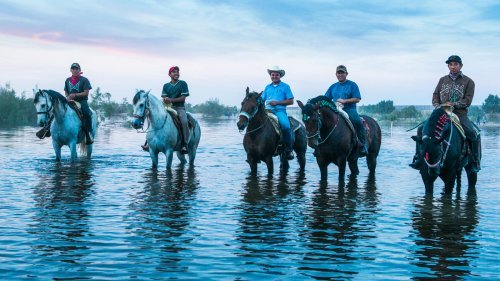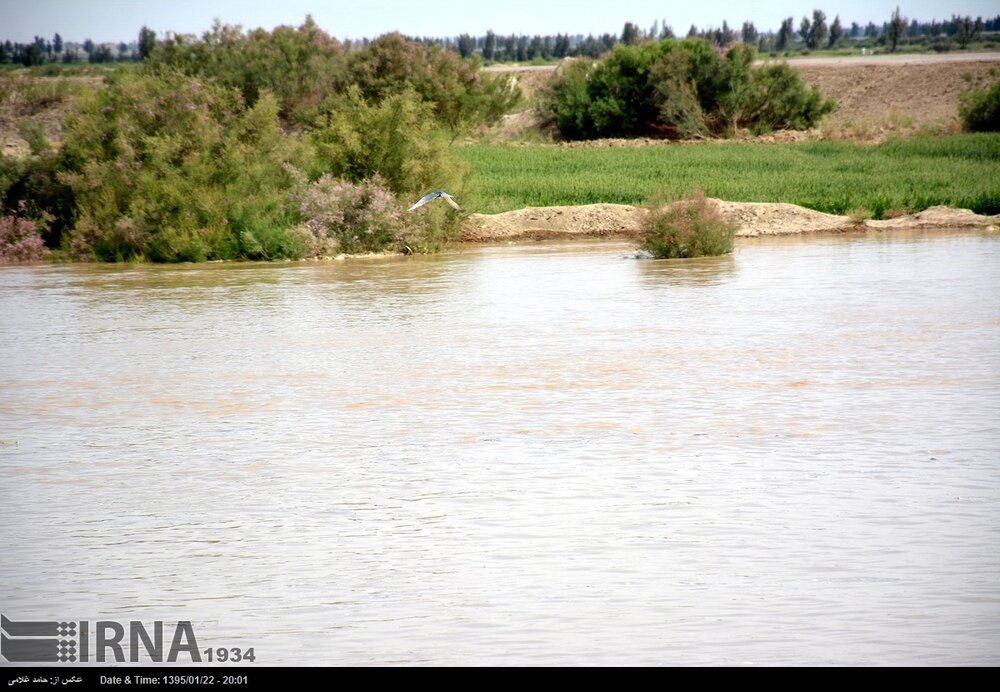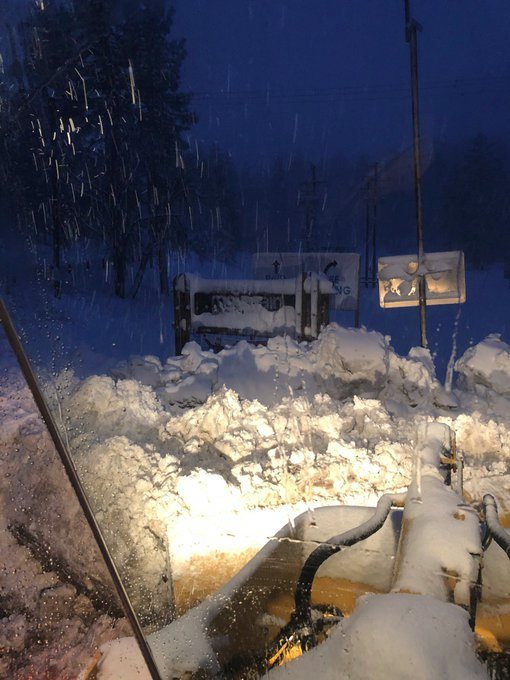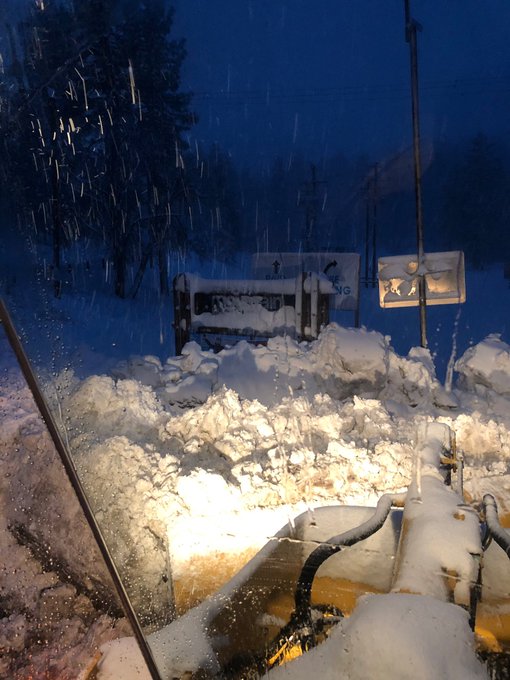"There is something fascinating about science. One gets such wholesale returns of conjecture out of such a trifling investment of fact.”
― From " Life on the Mississippi ", by Mark Twain, 1883

(Mexican cowboys celebrating the Colorado River “coming back to life”, 2014)
The photo above documents how the folks in charge opened up the Morelos Dam on the Colorado River in 2014, allowing river water to move due south down the historic river channel some 100 miles to the Sea of Cortez. Typically, the dam gates are sealed tight, diverting the last of the river into the Reforma Canal.
The opening of the dam was an Op, a feint. Later, they’d take credit for “saving the river” and for the exponential increase of life within it during that period just after 2012.
Summer 2020 was the fifth rainiest in Alaska’s history. Guess when the rainiest year in history in Alaska was? That would be 2014, the year of the Colorado river dog and pony show. The rainfall volume was so large in 2014 that they had to let the Colorado river’s water run by into its old channel, as holding it back would have destroyed all of their infrastructure, including the canal.
A story below from Iran from 2019 is headlined “After deluge Helmand River springs back to life”.
(Helmand River, Iran, revived by record rainfall after 18 years of intentional ruination)
"TEHRAN — After 18 years of dryness the almost dead Helmand River returned to life following recent torrential rainfalls, YJC reported on Saturday.
Dam construction, depriving the river from its water right , coupled with climate change have resulted in the dryness of the river over past years contributing to biodiversity loss, and sand and dust storms."
The folks in charge built the dam, turned off the water flow downstream of it, killed everything, and then blamed it on “climate change”. While using taxpayer dollars to do it. How they must laugh! I actually don’t know if they have taxes in Iran, but you know what I mean.
I had to do the math to learn that rainfall levels in Iran in 2019 were 154% higher than they were in 2018. And that rainfall levels in Iran’s Sistan-Baluchestan province in 2019 were 382% higher than they were in 2018.
Only when rainfall levels doubled and tripled and quadrupled were the folks in charge in Iran forced to let the water flow around the dam. If they had tried to hold it back, it would have blown the dam.
The author of the article doesn’t mention what’s driving the historically unprecedented rainfall in Iran.
An article below from 2020 is entitled “How a Dying River Came Roaring Back to Life”.
The article reads " Since the removal of two dams on the Elwha River in the Pacific Northwest, salmon are spawning once again, animals large and small are returning to the river banks, and hundreds of acres of barren former lakebed are greening."
The Elwha dam was removed in, wait for it, 2014, the same year they did the Colorado river dog and pony show to amaze the rubes. The rubes that they hoped wouldn’t notice that all the rivers were transforming back to health, at once.
In June, 2019, “global warming did it” was the plausible-deniability excuse used for the miraculous comeback of the Rio Grande river. In Rio Grande County, Colorado, no one could remember the last time their namesake river was closed to the public because it was running too high.
Another article below, from 2017, from England, is headlined “Sixty years ago, nothing could survive in the Thames – but today it is home to seals, porpoises and even the occasional stray whale”
Another article below from 2019, from Ohio, is headlined “How Ohio’s Cuyahoga River Came Back To Life 50 Years After It Caught On Fire”.
It reads “The Cleveland river’s 1969 burning inspired Randy Newman’s song and endless jokes. But its cleanup has been such a success that environmental officials travel from around the world to take notes .”
They’re posturing as if the rivers in all the nations weren’t reviving and transforming at once, as is in fact the case.
It’s an elaborate, ongoing, studious Op, which maintains that local efforts caused the transformation of the Cuyahoga, which took place coincident with all of the other rivers I’ve documented thus far in this article, and countless others.
The headline of a story from Australia from last month details an upcoming fake river-saving Op: “Controversial dredging plan to bring Noosa River back to life .”
And here’s a laugher from India from 2017: "How 700 Kerala villagers waded through a dead river, cleansed it and brought it back to life in 70 days ".
“The villagers first removed weeds and then plastic that was lodged solidly in the river bed. The next step was to dredge the water of pollutants and other debris dumped over the years.”
They “Removed weeds”. Wait, I’m laughing to hard I can’t type.
It’s not that the cleanups don’t exist, and it’s not as if the cleanups are not helpful (well, except for the “weed” pulling). They exist, and they are helpful. It’s just that they are incremental local efforts which do not address widespread increases in water quality and clarity that are being seen regardless of geography. They are public relations stunts.
A story below from this year from Australia is headlined " ‘Dead’ River Brought Back to Life by Rain in Central New South Wales".
No dams involved, here. Just the return of bountiful rainfall. The author bitterly closes with "The Central West region, where Wellington is located, is considered to be entirely in intense drought . "
Saying that the place where the drought was broken is still “entirely in intense drought” is an example of the use of conscious deception with the firmness of purpose that goes with complete honesty. It’s like how Nazi press releases steadfastly told the Germans the Nazi’s were winning up until the very last moment.
The tell in that paragraph is " intense drought". What, drought as defined isn’t negative enough? In journalistic parlance, that’s what’s referred to as “hyperbole”, or “piling on”.
Just last month, Pakistan had it’s highest ever 24-hour rainfall total, with 8.7 inches. The previous record, 8.3 inches, was set in 1976. The author provided the numbers of the old and new records, but carefully hedged by withholding the far more impactful percentage increase between them. So, I had to do the math. It’s 5% higher than the previous record .
Such records are usually broken by tiny margins. Here, the record stood for almost fifty years, and then was suddenly broken by a very large margin. There’s been a measurable, wholesale positive change in the environment in Pakistan.
A story below from April 2020 documents a new rainfall record for Downtown Los Angeles, 1.10 inches, breaking the old daily record of 0.84 of an inch from 1958.
The author provided the numbers of the old and new records, but carefully hedged by withholding the far more impactful percentage increase between them. So, I had to do the math. It’s 31% higher than the previous record.
Such records are usually broken by tiny margins. Here, the record stood for almost fifty years, and then was suddenly broken by a titanic, historically unprecedented margin.
A new rainfall record was also set at the Los Angeles International Airport. “A total of 1.22 inches was measured at Los Angeles International Airport, “topping” the previous record of 0.87 of an inch from 1984.”
Where “topping” implies that the new record just bested the old. The author provided the numbers of the old and new records, but carefully hedged by withholding the far more impactful percentage increase between them. So, I had to do the math. It’s 40% higher than the previous record .
Such records are usually broken by tiny margins. Here, the record stood for almost fifty years, and then was suddenly broken by an historically unprecedented margin. There’s been a measurable, wholesale positive change in the environment in Southern California.
Can you see how the author “buried” the larger margin beneath the smaller margin? There’s simply no quit in them.
The author continues bravely on: " Well over a foot of snow had already piled up across the high terrain of Southern California by Monday night."
(The caption of the picture in the article is " 18 inches and still snowing ". The author of the article hedged by describing that 18 inches as “well over a foot” of snow. - ed)
The tireless efforts of the controlled press to blunt and defray are not changing what’s going on, but are rather merely changing the perceptions of the populace as to what is going on. But as the evidence continues to pile up, it becomes clearer and clearer that the problem we face is not a controlled press, so much as mass mental illness at the societal level. Meaning that, when seals are showing up in London, and rivers are coming back to life as if by magic, one has to be insane to disavow that those things are happening.
The great news is that, if my thesis that moral and mental health vary directly with the health of the ether is correct, the sanity level of the general populace is going to continue to increase. Witness the great crime drop, and the rapidly dropping trust in large-scale Establishment confidence games, to name only two of many.
The folks in charge have nothing left but the propaganda. And, let’s face it, they never really ever had anything but the propaganda.
I think they’ve had it so soft for so long that they simply are no longer able to operate in a truth-based environment.
This is the end for them, I think.
Jeff Miller, Brooklyn, New York, October 6, 2020
November 12, 2015 - Sixty years ago, nothing could survive in the Thames – but today it is home to seals, porpoises and even the occasional stray whale
More than 2,000 seals have been spotted in the Thames over the past decade, according to a survey by the Zoological Society of London that ran from 2004 to 2014 and was published in August 2015, along with hundreds of porpoises and dolphins and even the odd stray whale.
May 17, 2017 - India - How 700 Kerala villagers waded through a dead river, cleansed it and brought it back to life in 70 daysThe villagers first removed weeds and then plastic that was lodged solidly in the river bed. The next step was to dredge the water of pollutants and other debris dumped over the years.
In warming West, Rio Grande roars back to life, for now
By Andrew Hay
4 MIN READ
TAOS, N.M. (Reuters) - After years of drought, no one in Rio Grande County, Colorado, can remember the last time their namesake river was closed to the public because it was running too high.
April 22, 2019 - Iran - After deluge Helmand River springs back to life
TEHRAN — After 18 years of dryness the almost dead Helmand River returned to life following recent torrential rainfalls, YJC reported on Saturday.
Helmand River which starts in the Hindu Kush Mountains in Afghanistan feed the Hamouns in Iran and Afghanistan. The Hamouns are transboundary wetlands on the Iran-Afghan border made up of three lakes: Hamoun-e Helmand, which is entirely in Iran, Hamoun-e Sabari on the border, and Hamoun-e Puzak, almost entirely inside Afghanistan.
Helmand River is the longest river in Afghanistan and the primary watershed for the endorheic Sistan Basin. Sistan Basin is an inland endorheic basin encompassing large parts of southwestern Afghanistan and minor parts of southeastern Iran, one of the driest regions in the world and an area subjected to prolonged droughts.
Dam construction, depriving the river from its water right, coupled with climate change have resulted in the dryness of the river over past years contributing to biodiversity loss, and sand and dust storms.
Based on the latest data published on Monday by National Drought Warning and Monitoring Center affiliated to Iran’s Meteorological Organization since the start of the current water year (September 23, 2018) the whole country received 290.1 millimeters of rain.
The number amounted to 114.1 millimeters in the previous water year and 198.3 millimeters in the long-term, the data indicated. The numbers show a drastic increase of 154.3 percent compared to last water year. It also reveals a 46.3 percent increase compared to long-term means.
The province of Sistan-Baluchestan also received 106.7 millimeters of rain in the same period which indicates 382.4 percent rise compared to last water year and a 6.4 percent increase compared to the long-term averages.
June 18, 2019 - How Ohio’s Cuyahoga River Came Back To Life 50 Years After It Caught On Fire
The Cleveland river’s 1969 burning inspired Randy Newman’s song and endless jokes. But its cleanup has been such a success that environmental officials travel from around the world to take notes.
June 19, 2019 - Strong run-off on the Rio Grande river is shown south of Pilar, New Mexico, U.S., June 19, 2019. Picture taken on June 19, 2019. REUTERS/Andrew Hay
But after the deepest snowpack in over two decades, topped off by a “bomb cyclone” spring storm in the Rockies, the raging, snowmelt-fed river has been shut to recreation in two Colorado counties.
The Rio Grande’s revival after one of its lowest years on record has brought relief to Indian pueblos, farmers and water managers along its course from the Colorado Rockies to the Gulf of Mexico. However, the future of the United States’ third-longest river, and that of other Southwest rivers, remains clouded by a warming climate.
Colorado rafting company owner Joel Condren is looking forward to an epic season this year, following 2018 when he could not open his business because the Rio Grande was too low.
This year he has the opposite problem, with the river running at up to 8,040 cubic feet per second at Del Norte, the greatest amount since 1985, according to Colorado state data.
2020 - The Bronx River Bounces Back | New York
New York’s Bronx River—once an open sewer—is now teeming with life. We discovered oysters, eels, herons, and even beavers, as we canoed through the poorest congressional district in America.
It was long abused by industry, neglected by the neighborhood, and forgotten by the City. But now New York’s only freshwater river is coming back to life.
January 16, 2020 - Australia - ‘Dead’ River Brought Back to Life by Rain in Central New South Wales
Widespread rain across the state brought relief to drought-affected areas in New South Wales, with Wellington receiving 34 millimetres of rain by mid-afternoon on January 17.
Despite the recent rainfall, the entire state of New South Wales is still considered to be in drought. The Central West region, where Wellington is located, is considered to be entirely in intense drought.
April 7, 2020 - NEWS / WEATHER FORECASTS
Record-setting storm to continue crawl over California into Friday
By Renee Duff, AccuWeather meteorologist
Published Apr. 7, 2020 7:20 AM
Copied
Volume 0%
In Palmdale, California, residents were hit with a bit of rain on Monday, April 6.
A nearly stationary storm will be slow to wring out all of its moisture over central and Southern California into the end of the week.
The storm has been pestering the region since the beginning of the week, bringing record-setting rainfall to some locales.
On Monday, Los Angeles and Lancaster, California, received more rain in 24 hours than they typically receive during the entire month of April. These cities joined Burbank and Palmdale, California, in setting new rainfall records for the date.
Downtown Los Angeles recorded 1.10 inches, breaking the old daily record of 0.84 of an inch from 1958. A total of 1.22 inches was measured at Los Angeles International Airport, topping the previous record of 0.87 of an inch from 1984.
Well over a foot of snow had already piled up across the high terrain of Southern California by Monday night.
(The caption of the picture in the article is “18 inches and still snowing”. The author of the article described 18 inches as “well over a foot of snow”. - ed)
By Tuesday night, 72-hour rainfall totals were between 5-7 inches in the higher ground of Southern California and 1-3 inches in the lower elevations.
High precipitation amounts such as these are not typical for April as the frequency of storms moving in from the Pacific Ocean lessens during the month, on average.
April 22, 2020 - How a Dying River Came Roaring Back to Life
Since the removal of two dams on the Elwha River in the Pacific Northwest, salmon are spawning once again, animals large and small are returning to the river banks, and hundreds of acres of barren former lakebed are greening.
August 5, 2020 - Australia - Controversial dredging plan to bring Noosa River back to life
August 18, 2020 - Alaska - NWS: 2020 marks a record for summer rainfall
Juneau, Alaska (KINY) - The National Weather Service in Juneau is reporting one of the wettest summers in the history of the region.
No doubt, given the amount of rain lately, NWS is recording 2020 as a record year for rainfall.
Through Monday, Aug. 17, Juneau International Airport had secured the fifth wettest meteorological summer, which is measured from June to August, with 19.89 inches of precipitation.
The wettest measurement at the airport was in 2014, with 24.27 inches.
August 28, 2020 - Record-breaking rainfall submerges Karachi, leaving more than 20 people dead, Pakistan
Parts of the city were submerged after being hit by the highest single-day rainfall in 53 years - 223.5 mm (8.7 inches) in 12 hours on Thursday, August 27.
This broke the previous 24-hour rainfall record of 211 mm (8.3 inches) set on July 26, 1976, the Pakistan Meteorological Department (PMD) confirmed.
If you’d like to be added to this free mailing list, please send me a note at [email protected].
You can access these articles online at https://forum.orgones.co.uk/c/positive-changes-that-are-occurring/


